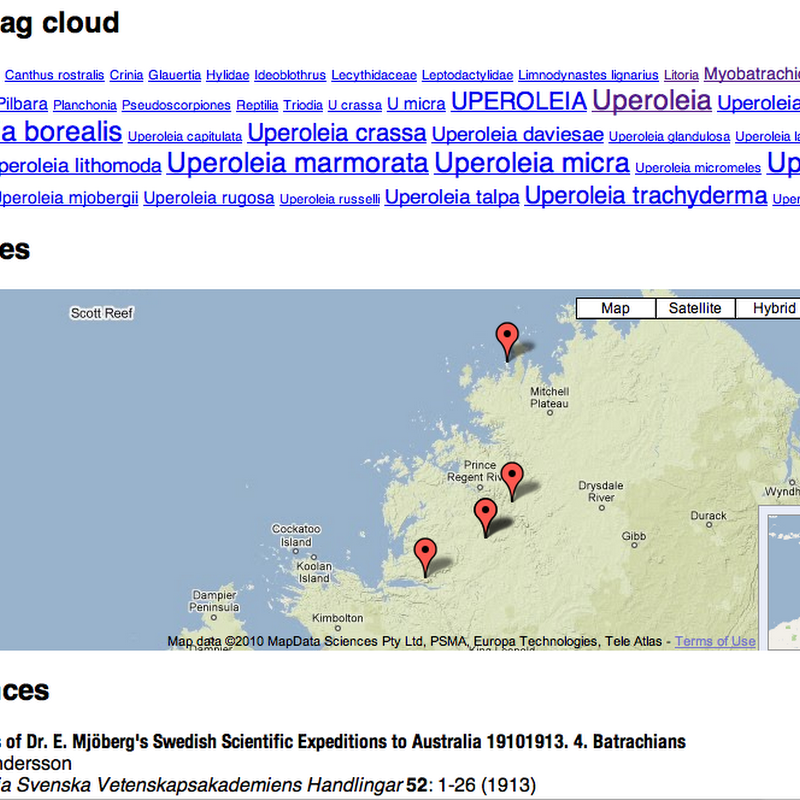
Garnett et al. recently published a paper in PLoS Biology that starts with the sentence "Lists of species matter": This paper (one of a forthcoming series) is pretty much the kind of paper I try and avoid reading.

Garnett et al. recently published a paper in PLoS Biology that starts with the sentence "Lists of species matter": This paper (one of a forthcoming series) is pretty much the kind of paper I try and avoid reading.

Holly Bik (@hollybik) has an opinion piece in PLoS Biology entitled "Let’s rise up to unite taxonomy and technology" https://doi.org/10.1371/journal.pbio.2002231 (thanks to @sjurdur for bringing this to my attention). It's a passionate plea for integrating taxonomic knowledge and "omics" data.

I've published a short note on my work on geophylogenies and GeoJSON in PLoS Currents Tree of Life : At the time of writing the DOI hasn't registered, so the direct link is here. There is a GitHub repository for the manuscript and code. I chose PLoS Currents Tree of Life because it is (supposedly) quick and cheap.

Quick note to highlight the following publication: This paper outlines the methods used by the BOLD project to cluster sequences into "BINS", and touches on the issue of dark taxa (taxa that are in GenBank but which lack formal scientific names). Might be time to revisit the dark taxa idea, especially now that I've got a better handle on the taxonomic literature (see BioNames) where the names of at least some dark taxa may lurk.

Jonathan Eisen recently wrote that the PLOS Hub for Biodiversity is soon to be retired, and sure enough it's vanished from the web (the original URL hubs.plos.org/web/biodiversity/ now bounces you straight to http://www.plosone.org/, you can still see what it looked like in the Wayback Machine).Like Jonathan, I was involved in the hub, which was described in the following paper:In retrospect PLoS's decision to pull the hub is not surprising.

One of the things I keep revisiting is the way we display scientific articles. Apart from Nature's excellent iPhone and iPad apps, most efforts to re-imagine how we display articles are little more than glorified PDF viewers (e.g., the PLoS iPad app).Part of the challenge is that if we make the article more interactive we immediately confront the problem of how to link to other content.

My paper describing the mapping between NCBI and Wikipedia has been published in PLoS Currents: Tree of Life. You can see the paper here. It's only just gone live, so it's yet to get a PubMed Central number (one of the nice features of PLoS Currents is that the articles get archived in PMC).Publishing in PLoS Currents: Tree of Life was a pleasant experience. The Google Knol editing environment was easy to use, and the reviewing process quick.

The PLoS Biodiversity Hub has launched today. There's a PLoS blog post explaining the background to the project, as well as a summary on the Hub itself:Readers of iPhylo may recall my account of one of the meetings involved in setting up this hub, in which I began to despair about the lack of readiness of biodiversity informatics to provide much of the information needed for projects such as hubs.

Continuing on from my previous post Viewing scientific articles on the iPad: towards a universal article reader, here are some brief notes on the PLoS iPad app that I've previously been critical of.There are two key things to note about this app. The first is that it uses the page turning metaphor. The article is displayed as a PDF, a page at a time, and the user swipes the page to turn it over.

I've just come back from a holiday in New Zealand, during which time I spent a morning chatting with Zhi-Qiang Zhang (@Zootaxa, editor of Zootaxa ) and Stephen Thorpe (stho002, a major contributor to Wikispecies).Fresh from playing with PLoS XML to explore ways of redisplaying articles (described in my commentary on the PLoS iPad app), I was extolling the virtues of the XML mark-up that underlies PLoS (and other Open Access journals, such